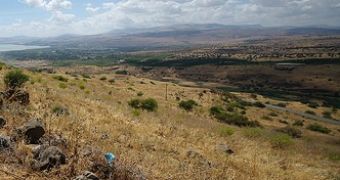This year sees the first excavation on Horvat Kur, a village inhabited from the Early Roman through the Early Medieval periods, located two kilometers west of the Lake of Galilee. Thirty volunteers from the Netherlands, Finland, Switzerland, Romania, Belgium, Spain, Israel, and Germany, explore the ruins of the Galilean village. This 2010 campaign is sponsored by the Universities of Bern, Helsinki and Leiden and it lasts from June 21 until July 16.
After two weeks of digging the Galilean village started to take shape. Archaeologists worked in two different areas. In area A, remains of a monumental wall were discovered even from the early stages of the excavation. It is preserved up to 80cm and runs North-South for at least 10 meters, dividing the excavated space into two areas. To the west, researchers think that there was a small courtyard. Large amount of coins were found in the 2008 and 2010 campaigns, suggesting that the building was in use since 400AD.
At the east of the wall, archaeologists concluded that there was the inside of the building. They found a low bench made of hewn stones and covered with grey plaster runs alongside the wall. They also found an entrance roughly in the center of its excavated part and uncovered the floor made out of grey hard plaster.
Considering the evidence, it seems that the Kinneret Regional Project 2010 discovered a part of the western wall of the third ancient Galilean synagogue. This adds new evidence of a very tight net of synagogues in a small area on the Northwestern shores of the Lake of Galilee.
Archaeologists also found ruins of what is believed to be an ancient village, thanks to dumped pottery from around 500AD. They found that village space was frequently reorganized to the needs of its growing population. Further analysis of earlier habitation will reveal the development of the village.
The Project will also continue its work on a large site on the shore of Lake Kinneret,, called Tel Kinrot. Until today excavations revealed settlement layers from the Chalcolithic throughout the Ottoman periods, about 5000 BC to the second millennium AD. This site was under Kinneret Regional Project's archaeological investigation until 2008. After that, a small team of experts started to analyze the findings from various settlement layers and prepare a consequent publication.
Future campaigns will survey the region around Horvat Kur in order to record agricultural installations, explore the caves and cisterns on the site to better understand the water supply system.

 14 DAY TRIAL //
14 DAY TRIAL //